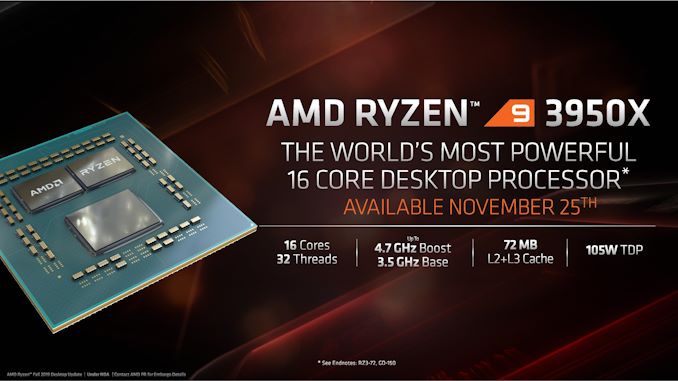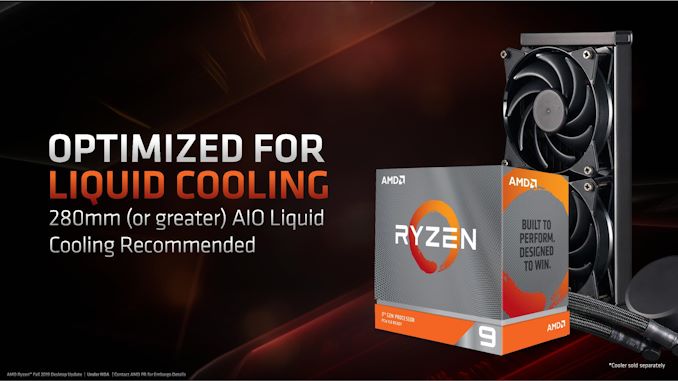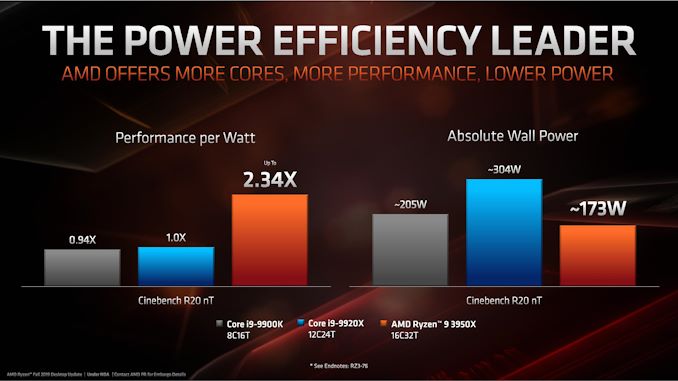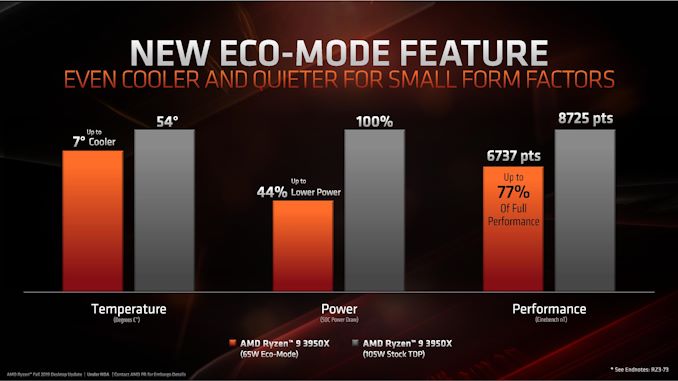AMD Q4: 16-core Ryzen 9 3950X, Threadripper Up To 32-Core 3970X, Coming November 25th
by Dr. Ian Cutress on November 7, 2019 9:00 AM ESTHigh-End Desktop? What’s That?
The Ryzen 9 3950X Comes Into View
As teased at E3 and seemingly every show that AMD has been to since, we’re now ready to get our hands on AMD’s top-tier consumer-grade processor. The Ryzen 9 3950X is the bigger cousin to the Ryzen 9 3900X, this time using two 8-core chiplets built on TSMC’s 7nm process with the Zen 2 microarchitecture. This is paired with the same I/O die, and overall this Ryzen 9 3950X will offer four more cores and +100 MHz on the turbo frequency over the 3900X, all at a $749 recommended retail price point.
| AMD 'Matisse' Ryzen 3000 Series CPUs | |||||||||||
| AnandTech | Cores Threads |
Base Freq |
Boost Freq |
L2 Cache |
L3 Cache |
PCIe 4.0 |
Chiplets IO+CPU |
TDP | Price (SEP) |
||
| Ryzen 9 | 3950X | 16C | 32T | 3.5 | 4.7 | 8 MB | 64 MB | 16+4+4 | 1+2 | 105W | $749 |
| Ryzen 9 | 3900X | 12C | 24T | 3.8 | 4.6 | 6 MB | 64 MB | 16+4+4 | 1+2 | 105W | $499 |
| Ryzen 9 | 3900 | 12C | 24T | 3.1 | 4.3 | 6 MB | 64 MB | 16+4+4 | 1+2 | 65W | OEM |
| Ryzen 7 | 3800X | 8C | 16T | 3.9 | 4.5 | 4 MB | 32 MB | 16+4+4 | 1+1 | 105W | $399 |
| Ryzen 7 | 3700X | 8C | 16T | 3.6 | 4.4 | 4 MB | 32 MB | 16+4+4 | 1+1 | 65W | $329 |
| Ryzen 5 | 3600X | 6C | 12T | 3.8 | 4.4 | 3 MB | 32 MB | 16+4+4 | 1+1 | 95W | $249 |
| Ryzen 5 | 3600 | 6C | 12T | 3.6 | 4.2 | 3 MB | 32 MB | 16+4+4 | 1+1 | 65W | $199 |
| Ryzen 5 | 3500X | 6C | 6T | 3.6 | 4.1 | 3 MB | 32 MB | 16+4+4 | 1+1 | 65W | OEM |
The Ryzen 9 3950X will be compatible in the majority of AM4 motherboards, although in order to take advantage of the 24 PCIe 4.0 lanes on the CPU, an X570 motherboard is recommended. The 16 cores offer a 3.5 GHz base frequency and a 4.7 GHz single core boost frequency; the overall all-core turbo frequency will be dependent on the motherboard used, the quality of the silicon, and the turbo in play.
The 105W TDP matches that of the 12-core part, and it should be noted that the 3950X will not come with an in-the-box cooler. Instead, AMD argues that customers looking at this price range of CPU typically go out and purchase their own, something better than the 125 W Wraith Prism that AMD might have put in the box. To that end AMD is going to publish a list of recommended cooling solutions that are pre-validated by AMD on the website, which should be live on today (the 7th).
Regarding BIOS and AGESA versions on motherboards: AMD has stated that AGESA 1.0.0.4B (also known as 1.0.0.4 Patch B) is going to be required in order to enable full performance on the Ryzen 9 3950X. AMD stated that this AGESA version actually unites several different groups of Ryzen CPUs under the same numbering scheme, to make it easier to manage. It is worth noting that when quizzed, AMD acknowledged that some motherboard manufacturers were putting out ‘beta’ versions of 1.0.0.4B, rather than the full release, and they recommend that users should wait for a full 1.0.0.4B version for their motherboard (even though some motherboard manufacturers aren’t exactly being clear).
In terms of performance, AMD claims a +22% single thread performance jump for the 3950X over the 2700X, in 1080p gaming the company claims it goes toe-to-toe against the Core i9-9900K and trounces the Core i9-9920X (a $1200 CPU), and in content creation it surpasses both the 9900K and 9920X by 18-79% in selected tests. The company also states that a 16-core 3950X uses less wall power than an 8-core 9900K system.
| Unlocked CPU Pricing and Select Others |
||||
| AMD (MSRP Pricing) |
Cores | AnandTech | Cores | Intel* (OEM Pricing) |
| $900-$999 | 18/36 | Core i9-10980XE ($979) | ||
| $800-$899 | ||||
| Ryzen 9 3950X ($749) | 16/32 | $700-$799 | 14/28 | Core i9-10940X ($784) |
| $600-$699 | 12/24 | Core i9-10920X ($689) | ||
| $500-$599 | 10/20 8/16 |
Core i9-10900X ($590) Core i9-9900KS ($513) |
||
| Ryzen 9 3900X ($499) | 12/24 | $400-$499 | 8/16 | Core i9-9900K/F ($488) |
| Ryzen 7 3800X ($399) | 8/16 | $350-$399 | 8/8 | Core i7-9700K/F ($374) |
| Ryzen 7 3700X ($329) | 8/16 | $300-$349 | ||
| $250-$299 | 6/6 | Core i5-9600K ($262) | ||
| Ryzen 5 3600X ($249) | 6/12 | $200-$249 | ||
| Ryzen 5 3600 ($199) | 6/12 | Below $200 | 4/4 | Core i3-9350K ($173) |
| *Intel quotes OEM/tray pricing. Retail pricing will sometimes be $20-$50 higher. | ||||
With Intel cutting its upcoming Cascade Lake-X HEDT processor line in half (and conveniently not releasing a 16-core part), the field does get a little more competitive for anyone looking at building a holiday system. What is important to note here is that AMD is shifting the line between consumer and high-end desktop higher: users spending $749 on a CPU get a ton of cores, but if they need more PCIe lanes, they have to go even higher to get the latest and greatest (see 3rd Gen Threadripper below). On a different note, AMD did state that Intel’s recent price adjustments had no effect on its product plans.
One side announcement from AMD, regarding all of the Ryzen 3000 hardware, is that every CPU now supports a cTDP down mode through the Ryzen Master software. With the tool, users can select the next power range down from the TDP of the processor. This means that 95W/105W CPUs can be set to run at 65W, then the 65W CPUs can be set to run at 45W, and the 45W CPUs can run at 35W.
AMD is doing this because they have seen a number of customers request high-core count processors at lower TDP values. Rather than releasing a wide array of X and non-X parts to satisfy all different areas of the market, AMD is offering this ‘cTDP down-like’ option for system builders that do want to focus on something like a 65W 16-core processor for their system. This isn’t to say that AMD will not release non-X CPUs in the future (they’re typically cheaper than the X CPUs), but rather than have customers wait for those parts to enter the market, AMD is giving this option to speed up adoption.














171 Comments
View All Comments
extide - Thursday, November 7, 2019 - link
Dependson your workloads. Both my desktop and work laptop have 64GB and I want to move my desktop at home to 128GB soon.close - Thursday, November 7, 2019 - link
I have a machine with 1024 cores and 2TB or RAM (no joke). I think the point of the comment above was that you don't *need* 64GB just because you need a TR.voodoobunny - Thursday, November 7, 2019 - link
... what do you *do*, and how can we do that too?imaheadcase - Thursday, November 7, 2019 - link
That is why these new CPUs are a slippery slope for people. At the end of the day even the hardcore gamer really has no incentive to upgrade past a CPU like the 2600K from Intel that was so popular. AMD is trying to put the "business" and "consumer" cpu in different category, but every year it seems kind of comical in most regards. Not saying that they don't have a advantage, but like you said the performance is getting to the point that you will not actually care about Mhz or core count, and more of feature sets of the CPU.Case in point:
"3.5 GHz base frequency and a 4.7 GHz single core boost frequency; the overall all-core turbo frequency will be dependent on the motherboard used, the quality of the silicon, and the turbo in play."
The last CPU i had boost was a 486dx intel cpu that went from 33mhz to 66mhz Boosted..even at that time i remember the controversy of it all. What i'm saving is when you get to a point that you have so many cores and are itching for a measly 100mhz or so its time to focus on integrating new tech into the cpu.
zmatt - Thursday, November 7, 2019 - link
Maybe your memory is foggy but the turbo on the 486 was a misnomer. It didn't make the cpu faster. 66mhz was the base clock. It halved the multiplier to run the cpu at 33mhz for games that didn't use the rtc. Many DOS games didn't support polling system time from the rtc because a lot of 386 and earlier systems didn't have them. So they kept time relative to the cpu cycles as a work around. I remember Liero did this and anything faster than a 16mhz 386 made the game actually run faster, to the point of unplayability. Unclocking the 486 via the turbo button helped, although on some games not enough.FreckledTrout - Thursday, November 7, 2019 - link
True. They all just misnamed the button turbo :) Which even back in the the 286 days I had a turbo button it of course worked as you described albeit lower frequencies.Xyler94 - Thursday, November 7, 2019 - link
There's more to a PC than raw CPU power.Platform features like PCIe version, SATA version, NVMe, some things that weren't even a sparkle in the eyes of engineers back in the Sandybridge days. Sure, if you only game, there's not too much of a difference, but there is a good one to say no to Sandybridge era CPUs in modern times. Hell, I wanna upgrade my 4790k, which is 3 years younger than Sandy Bridge.
The hardcore gamer have a lot of reasons to upgrade from Sandy, CPUs are faster, have more features, and newer stuff works better for newer OSs and such.
Threska - Thursday, November 7, 2019 - link
Instructions the earlier CPU didn't.**Reason I had to upgrade. The DRM needed it.
FreckledTrout - Thursday, November 7, 2019 - link
You have a point for the average person, CPU performance is pretty much a commodity. It took awhile but we have hit a point where people can reasonably afford more compute power than they need. However people who do real work like say video editing and don't have server farms these advances have been huge as they can never have to much compute.Spunjji - Friday, November 8, 2019 - link
This hasn't been true for around 2-3 years now, depending how you measure. Sandy had a long life (mainly thanks to its extremely conservative clock rates at stock) but it's way outside what I'd recommend to anyone looking to game even moderately seriously now.